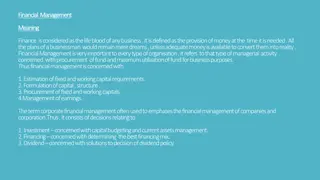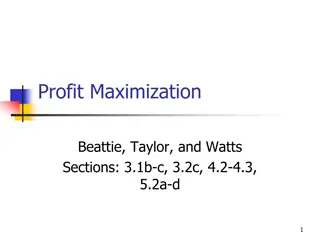Efficient Reverse Reachable Set Generation for Influence Maximization
This research revisits the influence maximization problem, focusing on efficiently generating reverse reachable sets with tightened bounds. The Independent Cascade (IC) model is explored along with existing solutions based on Random Reverse Reachable Set. The concept of RR sets and their significance in estimating expected influence are discussed, along with algorithms for RR sets-based IM. Key insights include the importance of covering RR sets for maximizing expected influence.
- Influence Maximization
- Reverse Reachable Sets
- Independent Cascade Model
- RR Sets-based Algorithms
- Network Analysis
Download Presentation

Please find below an Image/Link to download the presentation.
The content on the website is provided AS IS for your information and personal use only. It may not be sold, licensed, or shared on other websites without obtaining consent from the author. Download presentation by click this link. If you encounter any issues during the download, it is possible that the publisher has removed the file from their server.
E N D
Presentation Transcript
Influence Maximization Revisited: Efficient Reverse Reachable Set Generation with Bound Tightened Qintian Guo, Sibo Wang, Zhewei Wei, Ming Chen Influence Maximization Revisited: Efficient Reverse Reachable Set Generation with Bound Tightened 1
Influence Maximization (IM): Problem Definition Given a social network ?, a positive integer ?, Select ? seed nodes to maximize the expected number of influenced users under a certain cascade model. Two widely adopted models in the literature [Kempe et al. KDD 2003] Independent Cascade (IC) model (we focus on this model) Linear-Threshold (LT) model How the IC model works Each (directed) edge ?,? has a probability ??? ( ??? [0,1] ) The seed nodes are activated. Each newly activated node ? has one SINGLE chance to activate each of its outgoing neighbor ? with probability ??? It terminates when no node can activate other nodes 2 Influence Maximization Revisited: Efficient Reverse Reachable Set Generation with Bound Tightened
IC model: A Running Example ? ? 0.6 Inactive Node Active Node 0.2 0.3 0.2 Newly active node ? 0.1 Successful attempt ? 0.6 0.5 Unsuccessful attempt 0.2 0.7 ? ? 3 Influence Maximization Revisited: Efficient Reverse Reachable Set Generation with Bound Tightened
Existing Solutions Influence Maximization (IM): NP-hard State-of-the-art approximate solutions are based on the idea of Random Reverse Reachable Set [Borgs et al., SODA 2014] Providing (1 1 ? ?) approximation on expected influence Almost linear expected time complexity: ?(? ? + ? log?/?2) [Tang et al. SIGMOD 2015, Tang et al. SIGMOD 2018] 4 Influence Maximization Revisited: Efficient Reverse Reachable Set Generation with Bound Tightened
Reverse Reachable Sets (RR sets) A random RR set under IC model is generated as follows: Randomly sample a target node as activated Each activated node has one chance to activate its in-neighbors, i.e., following the reverse direction of the edges. Repeat until no nodes can be activated 0.6 ? ? 0.2 0.3 0.2 RR set = {?,?} ? 0.1 ? 0.6 0.5 0.2 Intuition 1: the RR set from ? is a sampled set of nodes that can influence node ? 0.7 ? ? 5 Influence Maximization Revisited: Efficient Reverse Reachable Set Generation with Bound Tightened
RR sets-based IM algorithms First sample a sufficient large number of random RR sets ?1= ?,? ,?2= ?,?,?,? ,?3= ?,? ,?4= ?,?,? ,?5= {?,?} We say that a set ? covers a RR set ? if ? ? Intuition 2: Given a large number of random RR sets, the more RR sets a node set ? covers, the higher expected influence ? has. The expected influence of set ? is estimated as: ? the fractional of RR-sets that are covered by ?. Assume that ? = {?,?}. Given random RR sets {?1, ,?5}, the expected influence of ? is estimated as 6 1 = 6 Then select the ? nodes that cover the most number of RR sets. Apply the greedy algorithm 6 Influence Maximization Revisited: Efficient Reverse Reachable Set Generation with Bound Tightened
RR set-based IM algorithms (cont.) Existing algorithms: RIS [Borgs et al., SODA 2014]: ? ? ? + ? log2?/?3 TIM/TIM+ [Tang et al., SIGMOD 2014]:? ? ? + ? log?/?2 IMM [Tang et al., SIGMOD 2015], SSA/D-SSA [Nguyen et al., SIGMOD 2016], OPIM-C [Tang et al., SIGMOD 2017] Retain the same time complexity as TIM/TIM+ Deficiency of existing RR set-based IM algorithms All these solutions focus on reducing the number of RR sets Sharing the same RR set generation algorithm. Existing RR set-based IM algorithms suffer from prohibitive computational cost under high influence networks Reason: The expected size of a random RR set becomes too large 7 Influence Maximization Revisited: Efficient Reverse Reachable Set Generation with Bound Tightened
Our Contribution SUBSIM: An efficient RR set generation algorithm Achieving an order of magnitude improvement over alternatives. Can be integrated into all existing RR set-based IM algorithms Improved time complexity For any node ?, the sum ?? of the weights of its incoming edges can be bounded by a constant ?: ?(? ? log?/?2) ? ? For any node ?, ?? can be bounded by O log???? : ?(? ? log log?/?2) HIST: An efficient framework to handle high influence networks Achieving 2 orders of magnitude improvement over alternatives Providing the same theoretical guarantee as alternatives 8 Influence Maximization Revisited: Efficient Reverse Reachable Set Generation with Bound Tightened
SUBSIM ?? Deficiency of the existing RR set generation algorithm Need to examine the in-neighbor of an activated node. Generate a random number for each edge. 0.1 ?? 0.1 ?? ? 0.1 SUBSIM: When all weights are equal: geometric sampling Generate a random integer ?~?(0.1) If ? = 7. Then, we skip 6 edges and directly sample the 7-th edge The expected cost can be bounded by ?(1 + ??). Here ?? is the sum of the weights of the incoming edges of node ?. 0.1 ?? 0.1 ??? For an arbitrary distribution, we can still use the idea of geometric sampling. Expected cost: still ?(1 + ??). Check our paper for the details! 9 Influence Maximization Revisited: Efficient Reverse Reachable Set Generation with Bound Tightened
Effectiveness of SUBSIM Varying k: Running time of IM algorithms under WC model. 10 Influence Maximization Revisited: Efficient Reverse Reachable Set Generation with Bound Tightened
Improved Time Complexity The time complexity of all previous IM algorithms includes the term ? Why? We need to examine all incoming edges of a node ? to sample the newly activated incoming neighbors. Now, we can jump to activated incoming neighbors. The cost is proportional to the expected number ?? of activated incoming neighbors If the expected number ?? can be bounded by a constant or ? log???? . We can improve the time complexity to ?(? ? log?/?2) or ?(? ? log ? ? log ? ?2). 11 Influence Maximization Revisited: Efficient Reverse Reachable Set Generation with Bound Tightened
HIST: Handling High Influence Networks Main idea of HIST: First select a set of ? sentinel nodes with a small number of random RR sets. Then, select the remaining ? ? nodes. Terminate the RR set generation as soon as a sentinel node is hit. The average size of random RR sets tends to reduce Average size of RR sets Main challenge: Retaining the approximation guarantee. Check our paper for the details. 12 Influence Maximization Revisited: Efficient Reverse Reachable Set Generation with Bound Tightened
Effectiveness of HIST Varying the average size of random RR sets ? WC variant: for each node ?, the weight of its incoming edges is min ????,1 Tune ?such that the average size is 50, 400, , 32,000 Varying ?: Running time under WC variant setting. 13 Influence Maximization Revisited: Efficient Reverse Reachable Set Generation with Bound Tightened
Conclusion SUBSIM: Efficient RR set generation with bound tightened. HIST: reducing the average size of random RR sets. 14 Influence Maximization Revisited: Efficient Reverse Reachable Set Generation with Bound Tightened
Thanks Download our code at: https://github.com/qtguo/subsim 15 Influence Maximization Revisited: Efficient Reverse Reachable Set Generation with Bound Tightened
Skew distributions Skewed distribution: RR set generation cost. 16 Influence Maximization Revisited: Efficient Reverse Reachable Set Generation with Bound Tightened
Effectiveness of HIST Impact of ? Varying k: Running time under WC variant setting. 17 Influence Maximization Revisited: Efficient Reverse Reachable Set Generation with Bound Tightened























